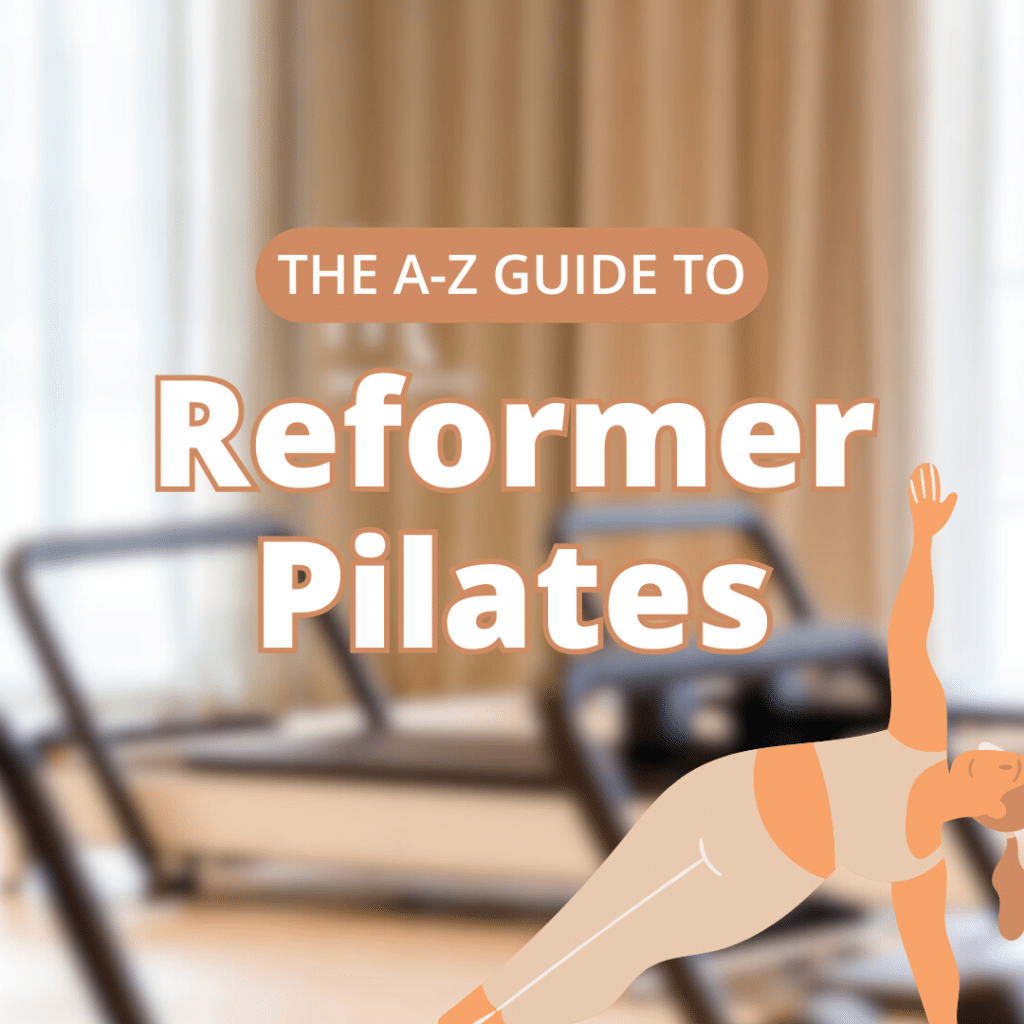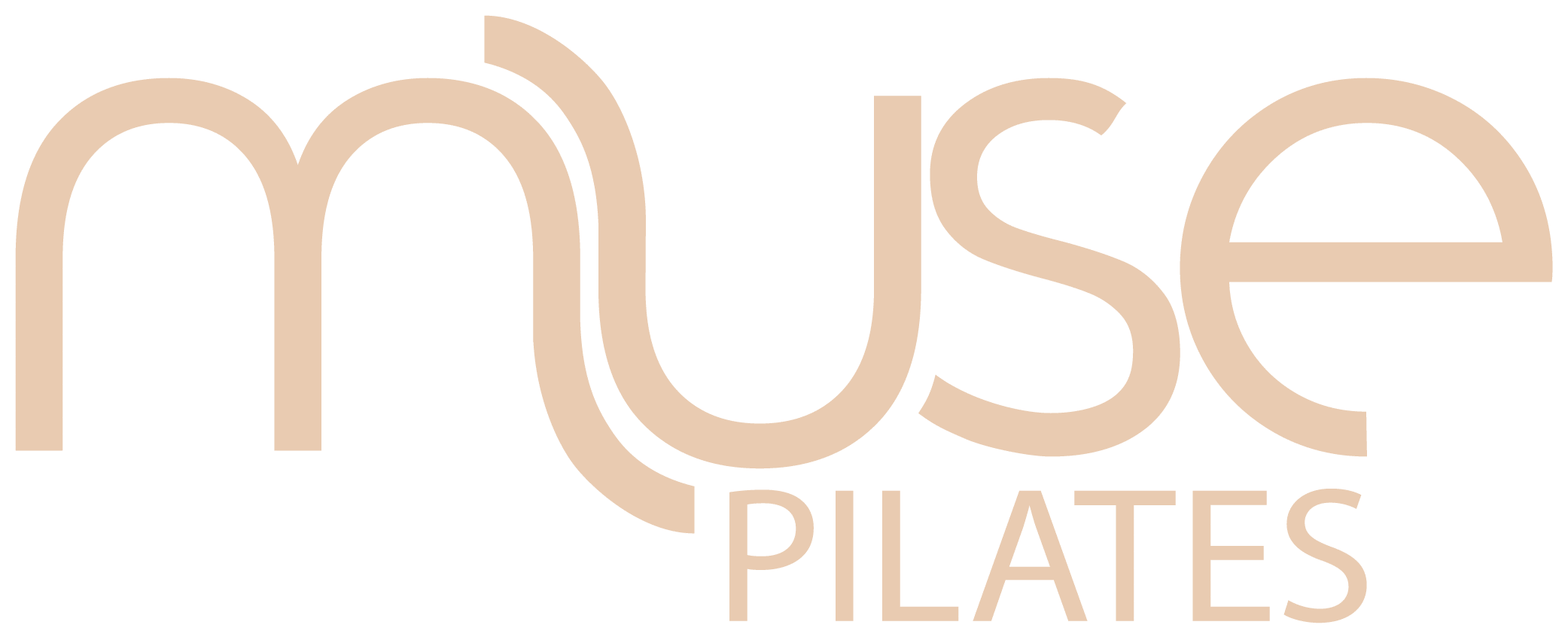
Jumping into the world of Pilates can feel both exhilarating and daunting. The unique terms and phrases found in reformer Pilates classes can initially seem like a secret code. Not to worry! We’re here to explore this dynamic and transformative exercise approach and help you understand many of the common terms and phrases that you’ll hear during a reformer Pilates class.
Whether you’re an experienced Pilates queen or a curious beginner asking, “What’s Reformer Pilates?” this comprehensive guide will provide clarity and insight into the key elements and explore the reformer Pilates definition.
What is Reformer Pilates?
So, what is Reformer Pilates?
At its core, Reformer Pilates is an evolution of the traditional Pilates method introduced by Joseph Pilates. While mat Pilates classes use your body weight for resistance, Reformer Pilates kicks things up a notch by using a piece of exercise equipment called the Pilates reformer machine. This machine is a sliding carriage rigged with springs, ropes and a pulley system designed to challenge your body.
Why do people love it? Reformer Pilates classes offer a full-body workout that aims for a great workout and ensures proper alignment and core stability. The adjustable spring tension allows for a customised resistance level, making it suitable for beginners and the most seasoned athletes. Whether you’re looking to sculpt your upper body, improve your posture or find that dynamic stretching groove, the reformer has you covered.
Led by certified Pilates instructors, these classes are more than just a series of Pilates exercises; they’re a journey towards a stronger, more flexible you. The reformer exercises are designed to provide a balanced body workout, focusing on strength training without adding bulk, and enhancing core stability for a lean, toned physique.
There are plenty of benefits of Reformer Pilates, from injury rehabilitation support to improved posture, core stability and overall well-being. Plus, options include individual classes in a Pilates studio or group reformer classes, so you can find the perfect fit for your lifestyle.
Reformer Pilates: Definitions and key terms
If you’re curious about stepping up your fitness game or searching for a challenging and rewarding workout regimen, Reformer Pilates might be the perfect fit. Your body (and mind) will thank you!
Before you get stuck in, take a look at our guide to the key definitions and terms you’ll hear at your first Reformer Pilates session. Read on!
A – Alignment:
The proper positioning of the body to ensure optimal posture and muscle engagement during Reformer exercises.
B – Carriage:
The moving platform on the Reformer where you perform various exercises. It glides back and forth on rails with the help of springs.
C – C-Curve:
The c-curve movement is an even rounding of your spine that works to stretch your back muscles and strengthen your core.
D – Dynamic:
Refers to the fluid and controlled movements involved in Reformer exercises. Dynamic Pilates aims to create strength and flexibility through a full range of motion.
E – Eccentric Contraction:
A type of muscle contraction where the muscle lengthens while under tension, commonly used in Reformer Pilates to strengthen and tone muscles.
F – Footwork:
A series of exercises performed with the feet on the footbar of the Reformer. Footwork variations target different muscle groups in the legs and promote proper alignment.
G – Grip:
Refers to how you hold onto the handles or straps during Reformer exercises. Maintaining a secure and controlled grip is essential for safety and effectiveness.
H – Headrest:
The adjustable cushioned part of the Reformer where your head rests during exercises. Proper headrest placement supports neck and spine alignment.
I – Inversion:
Some Reformer exercises involve the body being positioned upside down or at an inverted angle, challenging stability and core strength.
J – Jump Board:
An accessory that can be added to the end of the Reformer, allowing for cardiovascular exercises and dynamic movements, like jumping, while lying down.
K – Knees Off:
A position where your knees are lifted off the carriage during specific exercises, intensifying the engagement of the core muscles.
L – Lateral Flexion:
Movements that involve bending the spine sideways, targeting the muscles along the sides of the torso.
M – Muscle Imbalance:
A common focus in Reformer Pilates to address and correct uneven strength or flexibility between different muscle groups.
N – Neutral Spine:
The optimal alignment of the spine, maintaining its natural curves without excessive flexion or extension during exercises.
O – Overhead:
Exercises where the arms move overhead, often challenging the core and shoulder stability.
P – Prone:
To be in a ‘prone’ position means to be lying on the stomach with the face pointing upward.
Q – Quadruped:
A position where you’re on your hands and knees, often used for Reformer exercises targeting the core and stability muscles.
R – Resistance:
Provided by the springs on the Reformer, resistance is adjustable to challenge and strengthen various muscle groups.
S – Supine:
To be in a ‘supine’ position means to be lying on the back with the face pointing downward.
T – Teaser:
A challenging Reformer exercise where the body is lifted into a V-shape, targeting the core muscles.
U – Undercarriage:
The frame underneath the Reformer carriage that houses the springs and provides stability.
V – Variations:
Different ways to modify or progress Reformer exercises to accommodate different fitness levels and goals.
W – Wunda Chair:
Another piece of Pilates equipment, the Wunda Chair is occasionally used in conjunction with the Reformer to add variety and challenge.
X – X-Press:
A Reformer exercise involving a dynamic movement resembling a chest press while lying on the carriage.
Y – Yielding:
The intentional release of tension or resistance during certain phases of a Reformer exercise.
Z – Zip-Up:
Refers to engaging the core muscles and lifting the pelvic floor, creating a sense of length and support through the spine.
Explore the world of reformer Pilates with Muse Pilates
Understanding the A-Z of Reformer Pilates jargon might seem scary and overwhelming at first, but with our comprehensive guide and reformer Pilates definition, you’re now equipped with the knowledge to confidently step onto the Reformer and embrace the transformative world of controlled movements and dynamic strength building. You’ve got this!
Ready to jump into your reformer Pilates adventure? Experience our incredible Muse Pilates studios and community for yourself! Sign up for our exclusive introductory offer here.
